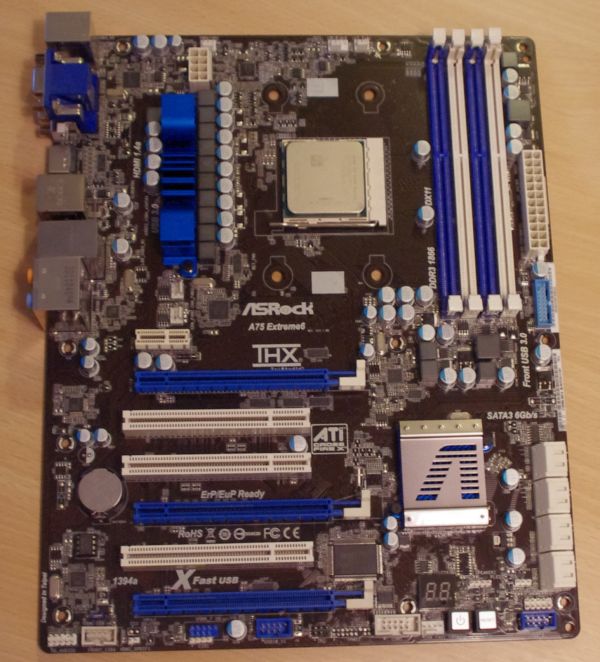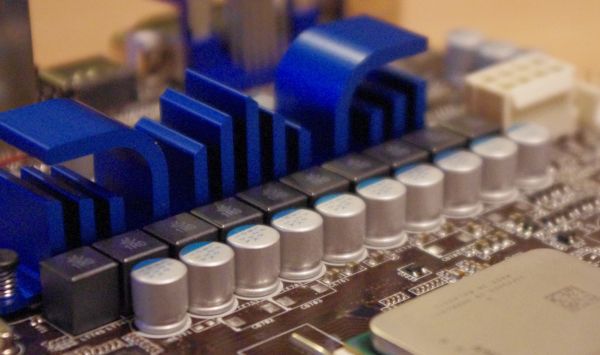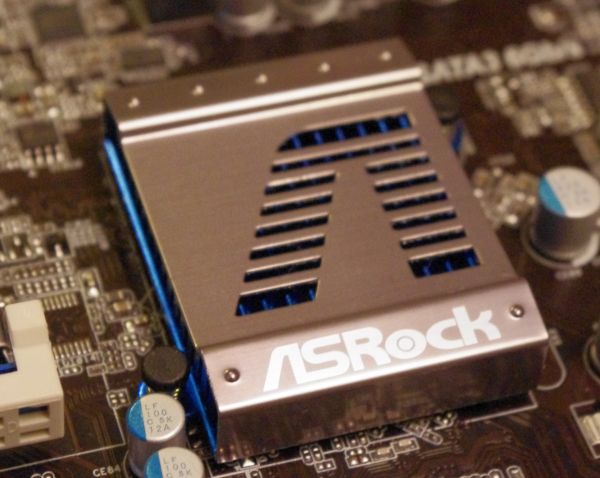Desktop Llano Motherboards: The ASRock A75 Extreme6 Preview
by Ian Cutress on June 14, 2011 12:00 AM EST- Posted in
- Motherboards
- ASRock
- Llano
The motherboard currently on the test bed is a pre-production model provided to us by ASRock, so I must stress that the design is not completely finalised. As far as I'm aware, the heatsink design isn't finished, nor the extras in retail package or the BIOS. I'm currently running a BIOS which requires some work to get finished, , hence I'm holding out for the retail product for a full review. But the board layout is done:
What we have is a fairly regular board with very few surprises. The AMD FM1 socket takes up a lot of space, and the 8+2 phase, without its final heatsink design, doesn't encroach on the socket area. There are plenty of fan headers around the socket—two for the CPU (one four-pin), one SYS and two chassis headers. This is a nice number of headers around the socket, as long as the software is there to control the chassis and CPU ones.
The four DIMM slots support DDR3-1866, and are located by an onboard USB 3.0 header. Underneath this are eight SATA 6 Gbps ports—six from the Fusion Controller Hub, and one from a controller. The usual ASRock Power/Reset and Debug LED combination is here (it is the Extreme6, we'd expect it to be), as well as two USB 2.0 headers, a COM header and a Firewire header. The FCH is tucked away under a small ASRock heatsink.
The PCIe layout makes full use of the three PCI that the A75/Hudson-D3 supports—by having three PCIe x16 and one PCe x1 at the top. The top two PCIe x16 are split x16/x0 or x8/x8, the bottom one is linked x4 via the UMI, but its throughput will be determined on what else is in use through the FCH. No doubt the lack of more PCIe x1 may be an issue for some.
The IO panel has some issues. There is a large gap above the HDMI port which with the right setup could have a couple more USB ports, but the biggest one by far is the DVI display port. With a cable in here, I had trouble getting any USB product, apart from a nano-USB stick, into the USB ports to the left—including my USB mouse and keyboard. It's a tight fit, and this oversight is courtesy of a lack of testing. Altogether, there's four USB 3.0 ports on the back, two USB 2.0 ports, a gigabit Ethernet port, a clear CMOS button, a Firewire port, an eSATA port and standard array of audio connectors.
BIOS and Overclocking
The BIOS on the ASRock board is similar to what we've seen in previous ASRock motherboards on the Sandy Bridge platform. As the board is not ready for release yet, it's still very rough around the edges. For now, it has a lot of options you wouldn't see, particularly in the RAM timing section, or the overclocking options.
What we can tell you right now is that overclocking is limited to the bus speed. This is confirmed by ASRock—even if the BIOS allows you to set a multiplier, this isn't actually implemented in the OS. Even if it's set at 36x, it'll still be 29x in reality. This means that there's little credence into many of the overclocked results you may have seen online—the only way to clock the processor is bus speed only. It starts at 100 MHz, and it's a case of raising and testing stability. With some minor testing, I hit 115 MHz quite easily (29*115 = 3.33 GHz), but I have a feeling it's going to be very dependent on the processor and motherboard.


























43 Comments
View All Comments
Hubb1e - Tuesday, June 14, 2011 - link
I don't understand the positioning of this board and others like it in the marketplace. Llano is a perfectly fine processor. I really like the concept and think it's a great CPU for my wife/mom/dad/brother/etc. I think it will be great in the marketplace. But at the shipping CPU speeds of less than 3ghz, it's not a gaming chip. Why all the motherboards with "Extreme" branding and 3 PCIe-x16 slots? Would anyone really get this CPU and crossfire it? That's the dumbest thing I've ever seen. The motherboards for this chip should be mainstream boards. It's an Athlon X4, not a Phenom at 3.5ghz. Maybe the motherboard makers know something I don't about the frequency capability of these chips, but unless these chips start shipping at 3.5-4ghz, there's no reason at ALL to launch an "Extreme" edition motherboard for these chips.Taft12 - Tuesday, June 14, 2011 - link
There's a very good reason to launch an "Extreme" Llano motherboard: High profit margin.Lolimaster - Tuesday, June 14, 2011 - link
You can overclock the system to 3.8Ghz~, so it's a pretty capable gaming system.You can also ran boinc exclusively on the IGP (openCL) and at the same time rock 6850 in CF with full speed (not as fast as on a SB/Zambesi).
buildingblock - Wednesday, June 15, 2011 - link
I agree with Hubb1e. The AMD strategy on LLano is to pair a comparatively weak CPU with a much better on-die GPU. To me this adds up to a budget option for those who don't want and are never likely to need a discrete graphics card. So Llano needs a budget-priced motherboard costing around the same as Intel's H61 boards.To show what the economics are, the Asrock Extreme6 P67 board costs $189 from NewEgg. Reasonably a Llano version should be around the same. One of the cheapest Intel H61 boards from NewEgg is the Asrock H61M-VS at $60. You can pair this with the Intel Core i3 2100 at $125 and have a board/CPU combo for $185, probably less than the price of the Asrock Extreme6 board on its own. If $185 is too much, the Asrock H61 can be paired with the Sandy Bridge G620 at $78 from Newegg. This gives a board/CPU combo costing $138.
In my opinion the superior GPU performance of Llano is not going to add to much in the budget market. The challenge for AMD is that they need a desktop board/CPU combo costing around $140 to compete with Intel. The fact is that Intel's HD2000 unit is good enough for normal GPU acceleration needed by Flash or browsers. The budget end of the market won't tolerate a significant price premium to pay for notionally better on-chip GPU performance which does not make any visible difference to ordinary users.
mino - Thursday, June 16, 2011 - link
because having x16 plus x4 plus three x1 slots looks much less "expensive" and also give the customer much less flexibility (RAID/NIC cards anyone?).Lolimaster - Tuesday, June 14, 2011 - link
Why an i5 2500K (over $200)Main competition on the same price segment of A8 3850 is the i5 2400 with the much worse HD2000. No point in including HD3000 for desktop since it's a useless IGP given that it's included in the most expensive cpu (this is a major intel failure, that IGP shoul've gone in nonK i3-i5).
buildingblock - Wednesday, June 15, 2011 - link
Intel has released the Core i3 2105. It's the 3.1Ghz 2100 paired with the HD3000. Already on sale and in stock at NewEgg for $140. This is a $15 premium over the ordinary 2100. The 2105 as a CPU is clearly able to match the Llano, it's just a question of how important the superior performance of the AMD graphics unit is going to be to buyers in this market segment. In my opinion, not at all - partly because they can pair the 2100/2105 with a budget priced Intel H61 motherboard and still get a motherboard/CPU combo for $200 or less. AMD will have a chance if they can get down to this price level. The problem otherwise is the elephant in the room, Ivy Bridge coming in Q2 2012. Both Bulldozer and Llano have already been delayed, and assuming they are both on the market in September this only gives AMD about two quarters before Ivy Bridge hits.IanCutress - Thursday, June 16, 2011 - link
Unfortunately, I don't have access to every CPU in every segment, being the motherboard editor. The only ones on hand were an i5-2500K, the results from my long gone i7-920, or a Fusion E-350. I have just received an X6 1100T, though didn't have time to test it. With the IGP in the i5-2500K, it seemed the best comparison tool out of those.Ian
zhonguuo - Tuesday, June 14, 2011 - link
very good web,believe you will love it.
FREE SHIPPING,accept pyapal
discount including evisu jeans,watches shirts,bags,hat and the decorations
trust me!
Quickly snapping up right
mino - Wednesday, June 15, 2011 - link
This is how the CPU reviews should have been written.